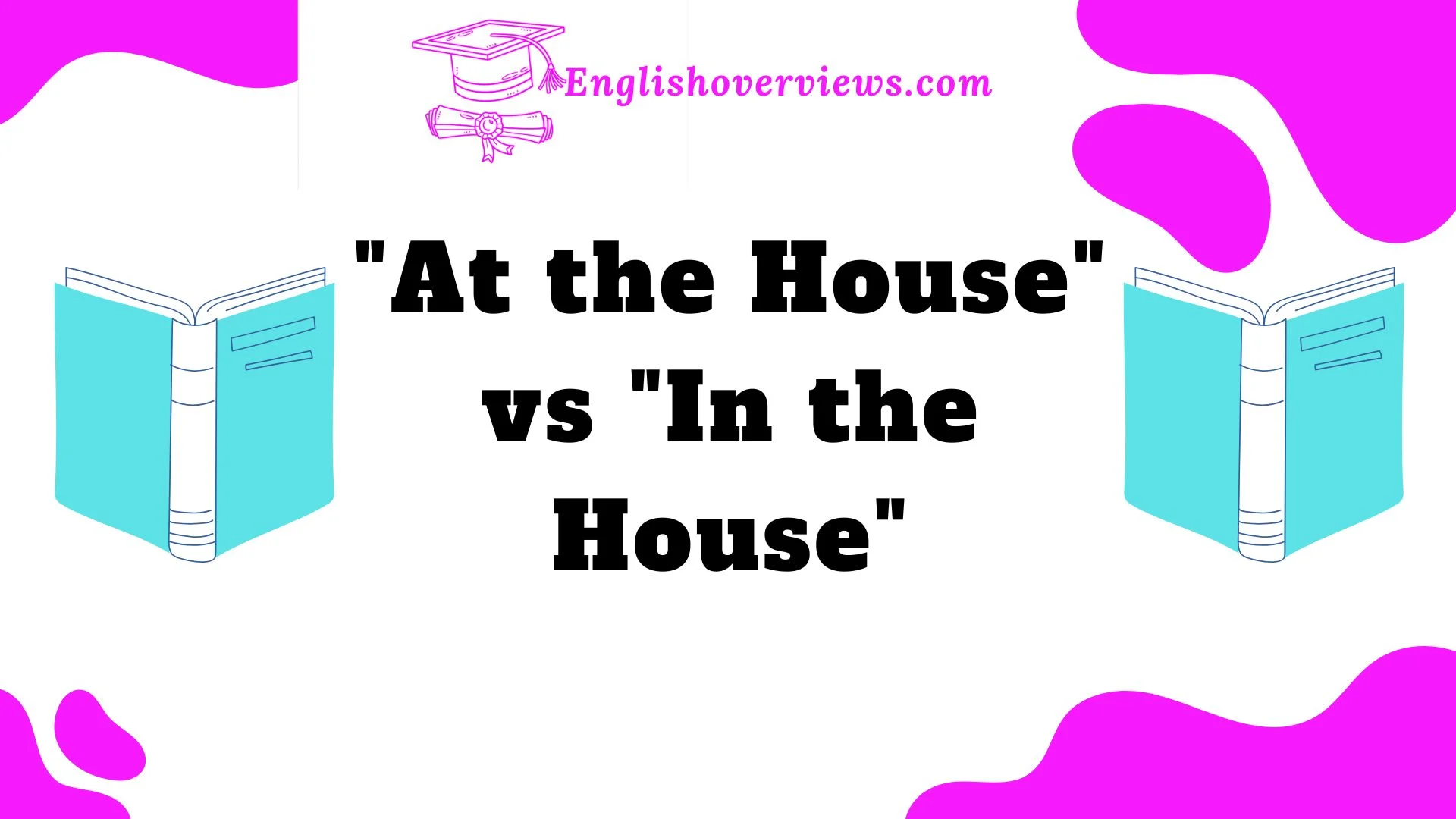Prepositions are the unsung heroes of the English language. Although small, these words pack a punch when it comes to conveying meaning. Take “at the house” and “in the house,” for example.
These phrases might sound similar, but the preposition you choose can completely change the meaning of the sentence. Understanding these subtle differences can help you communicate with greater precision and confidence.
In American English, prepositions like “at” and “in” can be tricky to navigate, especially when talking about locations. You may have asked yourself, “When should I say ‘at the house’ versus ‘in the house’?” This question pops up often, whether you’re learning English or just trying to refine your skills.
By the end of this post, you’ll not only understand the difference between these two expressions, but you’ll also know when and why to use them.
Let’s explore these two prepositions, starting with how they function in everyday language.
The Role of Prepositions in American English
Prepositions are words that show relationships between nouns (or pronouns) and other words in a sentence. They’re essential for indicating time, location, direction, or place.
For example, in the sentence “She is in the kitchen,” “in” is the preposition showing the relationship between “she” and “kitchen.”
English speakers use prepositions regularly, often without thinking much about them. But the choice of preposition can change the meaning of a sentence entirely.
For instance, saying “I am at the store” suggests you are near or around the store, whereas saying “I am in the store” means you are inside the store. So, while both sentences refer to the same general place, the prepositions convey different information.
In this post, we’ll focus on the prepositions “at” and “in” when referring to locations-specifically, when talking about being at the house versus in the house.
The Nuances of “At the House” in Everyday Language
The phrase “at the house” generally refers to a location that is either nearby or around the house, but not necessarily inside it. The preposition “at” suggests a more general location or point of reference, rather than specifying whether you’re inside the house or not.
Examples of “At the House” in Everyday Language:
- Meeting someone: “I’ll be at the house by 6 p.m.”
- Waiting for someone: “She’s at the house, waiting for us to arrive.”
- Describing a location: “The party is at the house tonight.”
Notice how “at the house” implies being near or around the house rather than physically inside it. It could even mean standing outside the house or being in the vicinity of it.
Examples of “At the House” in Different Contexts
Let’s take a closer look at some real-world examples where “at the house” can be used. Context plays a huge role in how we interpret prepositions, and “at” is very versatile. Whether you’re referring to a social event, a meeting, or even a casual hangout, “at the house” can work in many situations.
Social Gatherings:
- “I’ll meet you at the house later for the barbecue.”
- “The party is at the house this Saturday.”
Work or Professional Contexts:
- “I’m meeting with the client at the house this afternoon.”
- “The team will gather at the house for a strategy session.”
Everyday Situations:
- “I’m at the house, so give me a call when you arrive.”
- “We can discuss it at the house after dinner.”
In these examples, “at the house” doesn’t necessarily mean you are inside the house, but that you’re close to it, ready to engage in the activity.
When General Location Matters: The Usage of “At”
Understanding “at” is crucial when talking about locations because it signifies a point of reference. It doesn’t tell us whether someone is inside or outside the location, just that they are at that particular place.
When to use “at”:
- When referring to a general location (e.g., “We will meet at the house“).
- To describe an event near the location (e.g., “The wedding ceremony will take place at the house“).
- To show proximity to a specific location without specifying if someone is inside (e.g., “The delivery is at the house“).
Using “at” often implies a more flexible, general sense of location compared to other prepositions like “in.”
“In the House” – A Closer Look at Interior References
On the other hand, when you use “in the house,” you are clearly referring to being inside the house, not just near it. The preposition “in” indicates a specific interior space-you are inside the building itself.
Examples of “In the House”:
- “I am in the house right now.”
- “He’s in the house, cooking dinner.”
- “They are in the house watching a movie.”
Notice that “in the house” suggests a specific interior space, usually with a clear boundary, like the walls of the house, which you’re inside of. This is different from saying “at the house,” which doesn’t indicate whether you’re inside or outside.
Comparing “In the House” and “At the House” through Examples
Let’s compare the two phrases side by side to see how the meaning changes based on the preposition.
Example 1:
- At the house: “I’ll meet you at the house by 7 p.m.”
- This suggests you will meet near the house, outside, or in the vicinity. You don’t necessarily need to be inside.
- In the house: “I’m in the house, waiting by the door.”
- This clearly means you are physically inside the house.
Example 2:
- At the house: “The party is at the house.”
- Implies that the gathering will take place somewhere around or near the house, but doesn’t specify where in or outside the house.
- In the house: “The guests are in the house, enjoying the party.”
- This shows that the guests are physically inside the house.
Interior vs. Exterior: Clarifying the Distinctions
One of the main differences between “at the house” and “in the house” lies in their spatial references. “At the house” can describe both interior and exterior situations, but it doesn’t specify where. On the other hand, “in the house” always refers to the interior of the house.
Key Differences:
- At the house: General location, possibly outside or nearby.
- In the house: Refers specifically to being inside the house.
Visual Guide to Clarify:
| Phrase | Meaning | Example |
| At the house | Near or around the house | “I’m waiting at the house for my ride.” |
| In the house | Inside the house | “She is in the house, cooking dinner.” |
As you can see, the difference is subtle but important for effective communication.
Navigating Prepositional Use for Greater Precision in Language
Being mindful of prepositional usage is key when you want to communicate clearly and effectively. A lot of confusion arises from improper or inconsistent prepositional use. Whether you’re talking about an event or simply mentioning a location, choosing the correct preposition adds clarity.
How to choose:
- Use “at” when you mean proximity or a point of reference.
- Use “in” when referring specifically to the interior of a location.
Real-World Application:
- “She will arrive at the house around 4.”
- You don’t know if she will be inside or just outside; you’re focusing on the location.
- “He’s in the house, watching TV.”
- You know for sure that he is physically inside.
Popular Phrasing: Analyzing “At the House” and “In the House” in Literature and Media
In movies, books, and TV shows, these phrases are often used to create vivid imagery or set the scene. Both “at the house” and “in the house” help convey whether a character is inside or near a house, thus shaping the narrative.
Example from a Movie:
- “The thief was at the house, waiting for the signal.” (general location)
- “The thief sneaked in the house, careful not to wake anyone.” (specific location inside)
In literature, writers use these prepositions to evoke different spatial realities for their characters, influencing how we understand the setting.
Determining Which Preposition to Use in Specific Situations
The trick to choosing between “at” and “in” is context. Think about whether you’re referring to a general location or a specific space inside the house.
General Guidelines:
- Use “at the house” when:
- Referring to the house as a location point.
- Not specifying if you are inside or outside.
- Use “in the house” when:
- You are talking about being inside the house, surrounded by walls or rooms.
Conclusion
In American English, prepositions like “at” and “in” may seem small, but they carry significant meaning, especially when talking about location. By understanding the differences between “at the house” and “in the house,” you can ensure your communication is precise, accurate, and easy to follow.
Remember, “at” tends to be more general, while “in” is used for specific, interior locations. Knowing when to use each will elevate your English skills, whether you’re conversing in everyday situations, writing formal documents, or analyzing literature.
The key is understanding the context and choosing the preposition that best reflects the relationship between the place and the action.
FAQs
1. What’s the difference between “at the house” and “in the house”?
“At the house” refers to being near or around the house, but not necessarily inside. It suggests a more general location. “In the house” means being inside the physical space of the house, specifically within its walls.
2. When should I use “at the house”?
Use “at the house” when referring to a general location, such as an event, meeting, or a point near the house. It’s used when you’re not specifically inside the house.
3. Can “in the house” be used for something outside the house?
No, “in the house” always refers to being physically inside the house, not outside. If you are outside or near the house, you should use “at the house” instead.
4. Why is it important to choose the correct preposition like “at” or “in”?
Using the correct preposition helps avoid confusion. “At” and “in” indicate different relationships with the location, and using them properly clarifies whether you’re inside the house or just near it.
5. Can I use “at the house” and “in the house” interchangeably?
No, they are not interchangeable. “At the house” is more general and can refer to being near the house, while “in the house” specifies being inside the house itself.

English Overviews is a resourceful website dedicated to providing valuable content related to grammar and vocabulary. Muhammad Haroon has made notable contributions, sharing insights on various subjects, including WordPress themes and plugins. The primary goal of the site is to help users improve their English language skills effectively.











